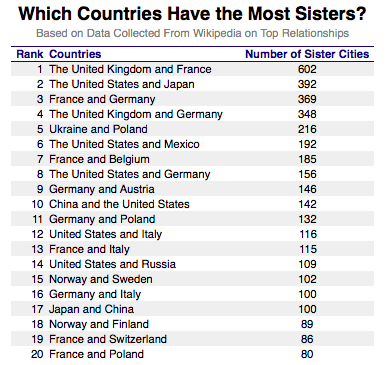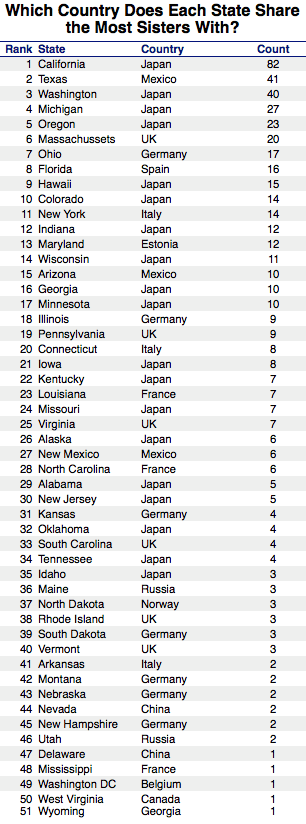In 2012, the towns of Dull, Scotland, and Boring, Oregon, chose to become family. In their union as “sister cities”, Dull and Boring joined thousands of pairs of towns and cities that have developed cultural and economic partnerships with a foreign counterpart.
While the pairing of Boring and Dull is primarily a gag to spur tourism, the sister city concept has a serious history. In fact, the creation and promotion of sister cities, which exploded after the devastation of World War II, originally came from no less noble a desire than to save the world.
We examined the history of sister cities and collected data on their current state. We found an institution that continues to bring former war adversaries together, and explains the diplomatic connections of different parts of the United States. We also learned that sister cities remain surprisingly relevant due to their possible economic benefits.
***
Children sitting in a devastated London during World War II
Following the incredible destruction and loss of life caused by World War II, international diplomacy focused avoiding such conflicts in the future. World leaders hoped to learn from the mistakes made after World War I that may have led to the recurrence of all-out war. The Marshall Plan and the creation of United Nations were the results of this desire.
But not everyone could engage in diplomacy on such a grand scale. Average citizens looked for ways to create a sense of international community. Out of this impulse came the incredible growth of sister cities, or “twin towns” as they call them across the pond, and the “citizen diplomacy” that is a part of sisterhood.
Sister Cities International, an American nonprofit that promotes sisterhood, defines sister cities as “broad-based, long-term partnership between two communities in two countries.” Through volunteers in the community, these sisters pursue “activities and thematic areas that are important to them and their community including municipal, business, trade, educational and cultural exchanges.” The hope is that engagement between the peoples of geographically distant communities might deter the misunderstandings that can lead to conflict.
The rise of sister cities began in Europe. Although sister city relationships existed before World War II (the cities of Le Mans, France, and Paderborn, Germany, claim to have become siblings in 836 AD), there were few such official arrangements. Soon after the war, the mayors and citizens of European towns that were opposed in battle began pairing up unofficially as a way to promote peace and understanding. By the 1950s, the Council European Municipalities, an association of European local governments, made the twinning movement a priority, which led to a “huge increase” in the number of sibling towns.
To better understand where sister cities have developed, we examined data on the most common pairs across the world by country. The data, which we collected from English Wikipedia, is likely incomplete, but academic researchers have found it to be the most comprehensive list available. The list includes over 15,000 cities in a sibling relationship.
The data reveals that the countries that share the most pairs are either former combatants and/or countries in close geographic proximity. The large number of sister cities in France and Germany likely evolved out of their desire to achieve peace like the one they now enjoy.

As we can see from the table, many American cities are in sister city relationships. The United States and Japan are second only to The United Kingdom and France in terms of sister city pairs.
The story of sister cities in North America is similar to that of Europe. Though a few sister city relationships involving a North American city predate World War II (like that of Toledo, Ohio, and Toledo, Spain), they were uncommon. After the War, a number of American communities decided to assist a European counterpart recovering from the war. The first mention of such a relationship is between Dunkirk, New York, and Dunkirk, France, which started in 1946 (sharing a similar name seems to lead to affinity).
And just as Europeans worried about maintaining positive relationships between former adversaries, many Americans wanted to cultivate a positive relationship with Japan.
The first American–Japanese sister relationship was established in 1955 between St. Paul, Minnesota, and Nagasaki, Japan. This was just ten years after the United States dropped a nuclear bomb on Nagasaki. The relationship, which was intended to “heal the wounds of the war”, has led to a variety of cultural exchanges between the two cities, including a Japanese garden opened in St. Paul and baseball games between the cities little league teams. St. Paul has a yearly remembrance of the devastation caused by the bomb.
The Japanese peace garden in St. Paul, Minnesota celebrates the sixty years of sisterhood between St. Paul and Nagasaki.
In 1957, President Dwight Eisenhower formalized and prioritized the development of sister city relationships by creating Sister Cities International. Sister Cities International is not an official part of the government, but since its founding, the sitting U.S. president has been an honorary chairman of the organization, giving the institution a special status.
Following Eisenhower’s promotion of sisterhood, the number of American relationships grew tremendously. Today, Sister Cities International recognizes over 2,100 partnerships between over 500 American communities with partners in 145 countries (there are many more partnerships not officially recognized).
Certain states in the U.S. are substantially more likely to have sister cities than others. The states with the most sister city relationships are the country’s most populous states: California (450), Florida (282) and Texas (158). But if we look at the number of sister city relationships per capita, we find a more interesting list. The two states with the most sister cities per person are Hawaii and Alaska, the two states not part of the contiguous U.S. Nine out of the top ten are coastal. It seems that coastal states have a more international outlook.

In addition to looking at the states that have the most sister cities, we also checked the most common country partner for the sister cities in each state. We found a geographic pattern to these relationships. States on the West Coast are much more likely to pair up with Japanese towns, while states on the East Coast are more likely to look to Europe. Perhaps the most surprising appearance on the list is that between Estonia and Maryland. Estonia and Maryland actually have a friendship partnership that goes back to the early 1990s. The states are ordered by those that have the most partnerships.

***
Though some have questioned the relevance of sister cities in the age of the internet and cheaper international travel, the number of sister city relationships continues to grow. There are now over 100 countries with at least ten sister cities. Out of the sister city movement has come less obvious relationships between cities, such as that of Ahmedabad, India, and Holguin, Cuba, as well as Split, Croatia, and Bandar Lumpung, Indonesia.
Today, the persistence of the sister city concept is less about keeping the peace than it is about generating cash.
Sister city relationships are now valued as a source for economic growth through increased tourism or trade. And in some case, for good reason. Charleston, South Carolina, generates $30 million a year from the Spoleto Festival USA, a festival focused on the performing arts of their sister city, Spoleto, Italy. The sister city relationship of Lakeland, Florida, and Chongming County in China led to a small engineering firm in Lakeland getting a more than one billion dollar contract to design a theme park in Chongming. San Antonio landed a Toyota Manufacturing plant likely, in part, because of its sister city relationship with Kumamoto, Japan.
Chicago and Mexico City have recently taken their sisterhood to the next level with the first ever “city-to-city trade agreement.” The agreement, intended to foster exchange in investment, education and innovation, will be overseen by the Brookings Institution’s Global Cities Initiative. These kinds of formal exchanges may be the future of city-to-city diplomacy.
Sister cities, a concept that came out of the instinct to avoid combat, seems to have morphed into a way to make profit. But perhaps these economic relationships actually serve the mission of keeping the peace as well as any cultural engagement. Some researchers believe that increased international trade decreases the likelihood of conflict between countries. In a way that the originators of the sister cities probably never imagined, the economic relationships of sibling communities may continue the institution’s purpose of preventing war.
![]()
Our next post explores the current turmoil in the karaoke industry. To get notified when we post it → join our email list.
This post was written by Dan Kopf; follow him on Twitter here.






